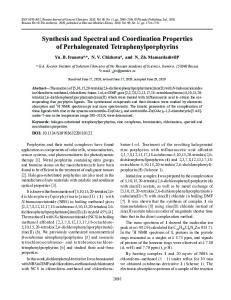Synthesis, structure, and properties of two coordination polymers constructed from 5-(isonicotinamido)isophthalic acid
- PDF / 1,481,041 Bytes
- 8 Pages / 595.276 x 790.866 pts Page_size
- 76 Downloads / 430 Views
Synthesis, structure, and properties of two coordination polymers constructed from 5‑(isonicotinamido)isophthalic acid Xiao‑Li Chen1 · Pan Zhu1 · Yi‑Fang Deng1 · Chun‑Hua Zhang1 · Liang‑Bing Sheng1 · Man‑Sheng Chen1 Received: 19 August 2020 / Accepted: 9 October 2020 © Springer Nature Switzerland AG 2020
Abstract Two three-dimensional (3D) coordination polymers, viz. [Ni(INAIP)(Him)(H2O)]·H2O (1) and [Fe(INAIP)(H2O)2]·H2O (2), were synthesized by reaction of 5-(isonicotinamido)isophthalic acid ( H2INAIP), NiSO4·6H2O/FeSO4·7H2O, and N-donor ligands, namely 1H-imidazole or 4,4′-bipyridine, under hydrothermal conditions. Single-crystal X-ray diffraction analysis indicated that [Ni(INAIP)(Him)(H2O)]·H2O has a two-dimensional (2D) layer network structure with (6, 3) topology, while 2 shows a 3D fourfold interpenetrating framework with (103-b) topology. The thermal stability and magnetic and adsorption behavior in solid state of the complexes were investigated in detail. Moreover, the photocatalytic degradation of methylene blue (MB) over complex 1 was studied. Keywords Coordination polymers · Crystal structure · Adsorption · Carboxamide ligand
Introduction In recent years, the rational design and synthesis of coordination polymers (CPs) using metal salts and functional organic ligands have attracted great attention, not only because of their intriguing variety of architectures and topologies, but also due to their potential applications in gas storage, catalysis, magnetism, and chemical sensing [1–9]. However, it is still a great challenge to exactly predict the structures and compositions of CPs, because even very small changes to tuning factors can dramatically affect the architecture of the framework. Of all such factors, the organic ligands play a crucial role in synthesis of functional CPs and can contribute to their structure and chemical properties [10–14]. Furthermore, mixed ligands with N-donor groups Electronic supplementary material The online version of this article (https://doi.org/10.1007/s11243-020-00432-6) contains supplementary material, which is available to authorized users. * Man‑Sheng Chen [email protected] 1
Key Laboratory of Functional Metal‑Organic Compounds of Hunan Province, Key Laboratory of Functional Organometallic Materials of Hengyang Normal University, College of Hunan Province, College of Chemistry and Materials Science, Hengyang Normal University, Hengyang 421008, China
acting as ancillary connector have proved to be effective building units to construct novel CPs. On the other hand, the most common industrial pollutants include dye wastewater, which is of concern worldwide due to the high chemical and biological stability of dye pollutants. Therefore, many physical and chemical treatment methods have been developed to remove dye contaminants [15, 16]. Among these methods, photocatalysis is considered to be an ecologically friendly, economical, and effective technique to degrade organic pollutants. According to the above considerations, with the aim of systematically explori
Data Loading...











